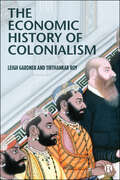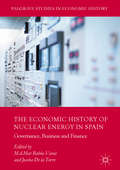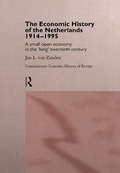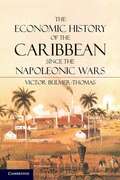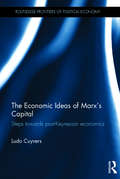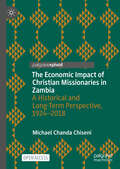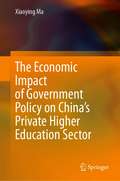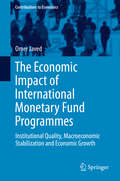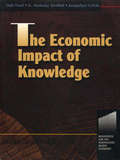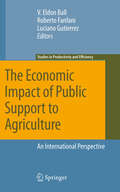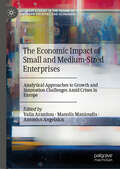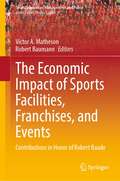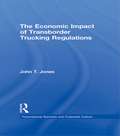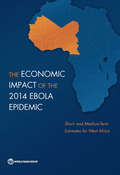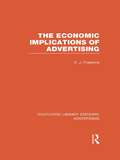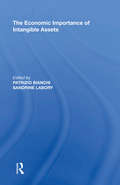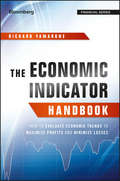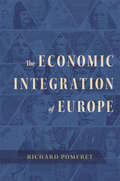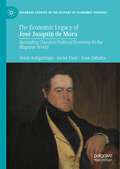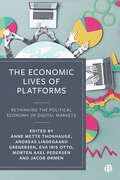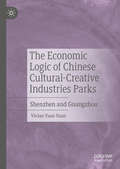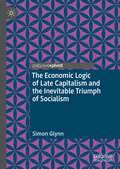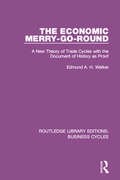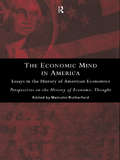- Table View
- List View
The Economic History of Colonialism
by Tirthankar Roy Leigh GardnerDebates about the origins and effects of European rule in the non-European world have animated the field of economic history since the 1850s. This pioneering text provides a concise and accessible resource that introduces key readings, builds connections between ideas and helps students to develop informed views of colonialism as a force in shaping the modern world. With special reference to European colonialism of the nineteenth and twentieth centuries in both Asia and Africa, this book: • critically reviews the literature on colonialism and economic growth; • covers a range of different methods of analysis; • offers a comparative approach, as opposed to a collection of regional histories, deftly weaving together different themes. With debates around globalization, migration, global finance and environmental change intensifying, this authoritative account of the relationship between colonialism and economic development makes an invaluable contribution to several distinct literatures in economic history.
The Economic History of Latin America since Independence
by Victor Bulmer-ThomasBeginning with the integration of Latin America into the world trading system centered on Europe and North America during the century before 1930, this book explores the successes and failures of export-led growth. Using new data on exports and a simple model to explore the relationship between exports and growth, the author pays particular attention to the question that has most concerned policy-makers in Latin America: how to transfer growth in the export sector to the rest of the economy, raising living standards and real income per head. The author examines the routes through which Latin American republics extricated themselves from the debt problem in pursuit of a new version of export-led growth. Taking its narrative from the end of the colonial epoch to the present, this book provides a comprehensive balanced portrait of the factors affecting economic development in Latin America.
The Economic History of Nuclear Energy in Spain
by M. d. Mar Rubio-Varas Joseba TorreThis book analyses the economic history of the nuclear program in Spain, from its inception in the 1950s to the nuclear moratorium in the early 1980s, and investigates the economic, financial and business origins of atomic energy in Spain. The actual dimension of the Spanish nuclear sector, which exceeded the relative economic and political clout of the country at the time, reflects the combination of domestic and foreign interests. Each contribution inserts the Spanish case within the international development of nuclear energy, but also shows how the Spanish nuclear program came about, how it was financed, and who the main architects and beneficiaries at the industrial, financial, commercial and banking levels were; all without losing sight of the energy policy aspects such as energy mix and energy security. The volume provides useful analysis and sources for a variety of core fields across the social sciences including economic history of post-war Europe, industrial and energy policy, international relations and history of technology.
The Economic History of The Netherlands 1914-1995: A Small Open Economy in the 'Long' Twentieth Century (Routledge Contemporary Economic History of Europe)
by Jan L. van ZandenJan L. van Zanden in The Economic History of the Netherlands 1914-1995 answers these questions. In the first four chapters the long development of the economy is analysed in detail. Central to this part of the book are the rise (and decline) of managerial enterprise; the growth (and fall) of trade unions; and the expansion (and crisis) of the welfare state. The particular Dutch features of these institutional changes are highlighted. The second part of the book deals with different periods of growth (from 1914-1929, and 1950-1973), and relative stagnation (1929-1950, and 1973-1995). Moreover, van Zanden examines the role the Netherlands played in the process of European integration, and gives an explanation of the success of the 'Dutch job machine' in the 1980s and 1990s.
The Economic History of the Caribbean since the Napoleonic Wars
by Victor Bulmer-ThomasThis book examines the economic history of the Caribbean in the two hundred years since the Napoleonic Wars and is the first analysis to span the whole region. It is divided into three parts, each centered around a particular case study: the first focuses on the nineteenth century ('The Age of Free Trade'); the second considers the period up to 1960 ('The Age of Preferences'); and the final section concerns the half century from the Cuban Revolution to the present ('The Age of Globalization'). The study makes use of a specially constructed database to observe trends across the whole region and chart the progress of nearly thirty individual countries. Its findings challenge many long-standing assumptions about the region, and its in-depth case studies shed new light on the history of three countries in particular, namely Belize, Cuba and Haiti.
The Economic Ideas of Marx's Capital: Steps towards post-Keynesian economics (Routledge Frontiers of Political Economy)
by Ludo CuyversNearly two hundred years have passed since the birth of Karl Marx and continuing to this day the influence of his economic views, insights and theories can still be felt. However, since the publication of Das Kapital, the scientific community has not been sitting idle – it is time to evaluate Marx as an economist and explore what he can bring to modern economic thinking, particularly post-Keynesian economics. Starting with Marx’s schemes of reproduction, which, it is shown, are the basis of the linear model of production as used since the 1960s by Piero Sraffa, Michio Morishima and others, the book reviews and assesses Marx’s major economic theses. These include: the labour theory of value; accumulation and technical change and its impact on labour; the concept of unproductive labour; the tendential falling rate of profits; the evolution and determinants of the share of wages in national income; as well as short-run and long-run economic dynamics. The Economic Ideas of Marx's Capital updates the theses of the labour theory of value and the conditions for balanced growth using the recent scholarly literature, and also further develops issues related to Marx’s concept of productive labour. Moreover, the book analyses the intellectual relationship of Marx’s economic theory with post-Keynesian neo-Marxism, particularly in the writings of Michal Kalecki, Joan Robinson and others. By doing so, the book shows the need and possibilities of integrating major insights of Marxist and post-Keynesian theory. This volume will be of interest to those who wish to explore Marx’s economic theories through a non-ideological approach, as well as students of Marxist economics, post-Keynesian economics and the history of economic thought.
The Economic Impact of Christian Missionaries in Zambia: A Historical and Long-Term Perspective, 1924-2018
by Michael Chanda ChiseniThis open access book examines the long-term impact of Christian missionaries in Zambia, and sub-Saharan Africa more generally, on education, health, and economic development. It examines how Christian missionaries provided Western-style education and healthcare within sub-Saharan Africa during the 20th century and how this was provided along unequal gender and regional lines. With sub-Saharan Africa currently facing challenges in the provision of essential public goods and services, the legacy of Christian missionaries in Zambia provides an insightful case study for better understanding how gendered education and regional health inequality have hindered economic development in this region. This book offers a new perspective on colonialism and the economic challenges faced within Africa. It will be relevant to students and researchers interested development economics and economic history.
The Economic Impact of Government Policy on China’s Private Higher Education Sector
by Xiaoying MaThis book provides an overview of the growth of the private higher education sector in China and in addition provides an analysis of some of the key drivers of this growth and impediments to it. What is new about the book is that it combines the results of a series of interviews with work that is more quantitative in nature. The book is of use to not only those engaged in academic research but also those who more generally wish to know more about an educational sector that is growing in importance. The most obvious factors promoting expansion of this sector have been the growth in per capita incomes, higher levels of participation in secondary school education, the strong growth in demand for graduates and the inability of the public sector to keep pace with demand. All of these factors intermingled with the involvement of government regulation. This regulation, however, is not uniform across all of China given the different provincial government departments of education that are also involved in dealing with private higher education institutions. In particular, this book looks at the way in which the Chinese government’s regulatory framework (both national and provincial) influenced the development of the sector and the way in which it operates, especially the private higher education component of that sector. The analysis undertaken finds that there is a link between regulation and the private higher education sector growth and a link between the funding of the government sector. The more intense regulation was, and the more funds provided to the state sector, the less scope there was for the private sector to expand. Growth of the private sector, therefore, did not just depend upon rising demand for higher education overall, but also to a fair degree of tolerance on the part of government. Much of this work, in subsequent years, has been supported by the further changes that have been undertaken in the Chinese higher education sector. Over the years, the growth of the Chinese higher education sector has stabilised, as has the private segment of this sector.
The Economic Impact of International Monetary Fund Programmes
by Omer JavedThis bookinvestigates the impact of International Monetary Fund (IMF) programmes onmacroeconomic instability and economic growth in recipient countries. Employingthe New Institutional Economics approach as an analytical framework, it identifiesthe determinants of economic and political institutional quality by taking intoaccount a broad variety of indicators such as parliamentary forms ofgovernment, the aggregate governance level, civil and economic liberties,property rights etc. The book subsequently estimates the impact of theseinstitutional determinants on real economic growth, both directly and alsoindirectly, through the channel of macroeconomic instability, in recipientcountries. Moreover, it illustrates the effectiveness of IMF programmes in thecase of Pakistan, a frequent user of IMF resources.
The Economic Impact of Knowledge (Resources For The Knowledge-based Economy Ser.)
by Dale Neef Tony Siesfeld Jacquelyn CefolaFirst Published in 1998. Routledge is an imprint of Taylor & Francis, an informa company.
The Economic Impact of Public Support to Agriculture
by Luciano Gutierrez Roberto Fanfani Virgil BallThe recent reforms of the Common Agricultural Policy (CAP) of the European Union extend in a significant way the "decoupling" process started some ten years earlier. By adopting the Single Farm Payment (SFP) scheme only limited support for agriculture is tied to current production decisions. This is also true of U.S. farm policy. The reform act of 1996 introduced greater planting flexibility, shifted some support to direct payments, and eliminated the authority for acreage reduction programs. The 2002 and 2008 Acts retained these features. However, they added countercyclical components to direct payments based on market prices and historic production, and allowed for updating of base acreage underlying direct payments. These steps arguably reintroduced ties between support and production decisions. This volume explores the economic implications of these recent changes in the design of agricultural policies for the economic performance of the sector in the European Union and the United States. The book is organized around five themes: (1) New Directions in Agricultural Policy: U.S. and EU Perspectives; (2) Agricultural Policy and Economic performance; (3) Energy and Agricultural Policy; (4) International Trade and Agricultural Policy; and (5) Commodity Programs and Risk Management. The authors apply rigorous tools to analyze the impact and implications of current agricultural policies on efficiency, productivity, and competitiveness in the sector, and consider opportunities for improvement in policymaking and practice.
The Economic Impact of Small and Medium-Sized Enterprises: Analytical Approaches to Growth and Innovation Challenges Amid Crises in Europe (Palgrave Studies in the Future of European Societies and Economies)
by Manolis Manioudis Valia Aranitou Antonios AngelakisSmall and medium-sized enterprises (SMEs) play a vital role in the global and European economy. This book offers readers an enhanced theoretical overview of key features of SMEs to help economists and policymakers address emerging challenges within policy frameworks. The book considers the latest trends and provides holistic perspectives on recent evidence in the performance and economic growth challenges of SMEs. It also highlights the business environment and landscape in Europe today. Chapters explore aspects regarding the policy implications, while reflecting on the underlying issues SMEs have when it comes to their access to finance, technology, innovation, green and digital transition, internationalization, and growth.
The Economic Impact of Sports Facilities, Franchises, and Events: Contributions in Honor of Robert Baade (Sports Economics, Management and Policy #23)
by Victor A. Matheson Robert BaumannThis edited volume discusses the economic impact of sports facilities, franchises, and events on local economies. Written in honor of Robert Baade upon his retirement, the book provides a state-of-the-art of current research on the economic impact of sports, and recognizes the seminal contributions that Dr. Baade has made to this topic.The analysis of the economic impact of spectator sports is a vital public policy topic as $75 billion has been spent on stadium construction since 1990 in the US alone, with nearly $35 billion of this coming from taxpayer subsidies. True public cost of sports franchises is much higher than this as this figure excludes facilities outside the Big 5 domestic leagues (like NASCAR track, NCAA facilities, minor league baseball, and the Canadian Football Leagues), public subsidies for major events like the Super Bowl or Olympic Games, and excludes sports subsidies outside of direct stadium construction subsidies.Including contributions from many of the most notable researchers studying the economic impact of sports, topics include impacts of stadiums and franchises on local economies, labor markets, and tax collections, the effect of sports franchises on property values, and changes in the public and academic discourse on sports subsidies over time. This volume will be of interest to researchers and students of sports economics, management, public policy, and public finance.
The Economic Impact of Transborder Trucking Regulations (Transnational Business and Corporate Culture)
by John T. JonesFirst Published in 1999. Routledge is an imprint of Taylor & Francis, an informa company.
The Economic Impact of the 2014 Ebola Epidemic
by The World BankBeyond its terrible toll in human lives and suffering, the Ebola epidemic has inflicted a measurable economic impact on West Africa in terms of forgone output, higher fiscal deficits, rising prices, lower real household incomes, and greater poverty. This impact results partly from the health-care costs and forgone productivity associated with being infected, but it is driven principally by the efforts of the uninfected population to avoid exposure ('aversion behavior'). The Economic Impact of the 2014 Ebola Epidemic: Short- and Medium-Term Estimates for West Africa provides a mixed methods analysis of the economic impact, combining theory on the channels of economic impact of the epidemic, economic indicators across sectors in the affected countries, and models of how these economies interact with each other and with the broader world. The result is a quantification of the potential overall magnitude of the economic impact for Guinea, Liberia, and Sierra Leone, as well as for West Africa as a whole. Ebola's short-term economic impact (2014) in the three core countries is on the order of US$359 million in forgone output: That is how much poorer these economies will be than they would have been in the absence of Ebola. Two alternative scenarios are used to estimate the medium-term impact (2015): A Low Ebola scenario corresponds to rapid containment within the three most severely affected countries and limited regional contagion, and a High Ebola scenario corresponds to slower containment in the three core countries with broader regional contagion. The estimates of the output lost as a result of the epidemic in the three core countries for 2015 alone sum to US$97 million under the Low Ebola scenario (implying some recovery from 2014) and US$809 million under the High Ebola scenario. Over the medium term, however, epidemiological and economic contagion are likely in the broader sub-region of West Africa. This report uses a multi-country general equilibrium model to estimate the medium-term impact on output for West Africa as a whole. Under the Low Ebola scenario, the loss in GDP for the sub-region is estimated to be US$2.2 billion in 2014 and US$1.6 billion in 2015. Under the High Ebola scenario, the estimates are US$7.4 billion in 2014 and US$25.2 billion in 2015. These are major regional impacts with global implications. This report will be of particular interest to policy makers and others interested in understanding the broader impact of the Ebola epidemic and in assisting with the subsequent economic recovery.
The Economic Implications of Advertising (Routledge Library Editions: Advertising)
by Otto John FirestoneIs advertising a factor that contributes to rising costs and prices? This study, commissioned to answer just that question by the Institute of Canadian Advertising, examines the effect of advertising on the Canadian economy, on business, the consumer, costs and prices, productivity, competition, employment, social welfare and economic growth. The Economic Implications of Advertising provides a valuable insight into a little-studied area of advertising, and will be of great interest to students of the industry everywhere. First published in 1967.
The Economic Importance of Intangible Assets
by Patrizio BianchiThis book is the result of a two-year interdisciplinary research programme named PRISM (Policy making, Reporting and measuring, Intangibles, Skills development and Management), financed by the European Commission and aimed both at understanding better how these assets are created and developed and what the policy implications of their growing importance in economies are. The book focuses on the policy issues raised by the increasing importance of intangible assets in a country's growth and competitiveness. The main idea is that the value of intangible assets, which is imperfectly captured by current economic indicators and imperfectly formalized in economic theory, lies in their being the cumulative elements that keep the economy together - the glue of the system. This argument leads to the focus on networks and social capital as drivers of the development of intangible assets and is illustrated by the case of EU innovation and knowledge diffusion policy.
The Economic Indicator Handbook: How to Evaluate Economic Trends to Maximize Profits and Minimize Losses
by Richard YamaroneAnalyze key indicators more accurately to make smarter market moves The Economic Indicator Handbook helps investors more easily evaluate economic trends, to better inform investment decision making and other key strategic financial planning. Written by a Bloomberg Senior Economist, this book presents a visual distillation of the indicators every investor should follow, with clear explanation of how they're measured, what they mean, and how that should inform investment thinking. The focus on graphics, professional application, Bloomberg terminal functionality, and practicality makes this guide a quick, actionable read that could immediately start improving investment outcomes. Coverage includes gross domestic product, employment data, industrial production, new residential construction, consumer confidence, retail and food service sales, and commodities, plus guidance on the secret indicators few economists know or care about. Past performance can predict future results – if you know how to read the indicators. Modern investing requires a careful understanding of the macroeconomic forces that lift and topple markets on a regular basis, and how they shift to move entire economies. This book is a visual guide to recognizing these forces and tracking their behavior, helping investors identify entry and exit points that maximize profit and minimize loss. Quickly evaluate economic trends Make more informed investment decisions Understand the most essential indicators Translate predictions into profitable actions Savvy market participants know how critical certain indicators are to the formulation of a profitable, effective market strategy. A daily indicator check can inform day-to-day investing, and long-term tracking can result in a stronger, more robust portfolio. For the investor who knows that better information leads to better outcomes, The Economic Indicator Handbook is an exceptionally useful resource.
The Economic Integration of Europe
by Richard PomfretThe clearest and most up-to-date account of the achievements—and setbacks—of the European Union since 1945. Europe has been transformed since the Second World War. No longer a checkerboard of entirely sovereign states, the continent has become the largest single-market area in the world, with most of its members ceding certain economic and political powers to the central government of the European Union. This shift is the product of world-historical change, but the process is not well understood. The changes came in fits and starts. There was no single blueprint for reform; rather, the EU is the result of endless political turmoil and dazzling bureaucratic gymnastics. As Brexit demonstrates, there are occasional steps backward, too. Cutting through the complexity, Richard Pomfret presents a uniquely clear and comprehensive analysis of an incredible achievement in economic cooperation. The Economic Integration of Europe follows all the major steps in the creation of the single market since the postwar establishment of the European Coal and Steel Community. Pomfret identifies four stages of development: the creation of a customs union, the deepening of economic union with the Single Market, the years of monetary union and eastward expansion, and, finally, problems of consolidation. Throughout, he details the economic benefits, costs, and controversies associated with each step in the evolution of the EU. What lies ahead? Pomfret concludes that, for all its problems, Europe has grown more prosperous from integration and is likely to increase its power on the global stage.
The Economic Legacy of José Joaquín de Mora: Spreading Classical Political Economy in the Hispanic World (Palgrave Studies in the History of Economic Thought)
by Jesús Astigarraga Juan Zabalza Javier UsozThis book examines the dissemination, adaptation, and application of classical economic ideas within the Hispanic world through the life of José Joaquín de Mora. Focusing on the decades surrounding the creation of the Latin American republics, it highlights how ideas from the classical political economy, including liberalism and free trade, were pioneered in the work of Mora and disseminated across the Spanish speaking world. Particular attention is given to the influence of Mora in Argentina, Chile, Peru, and Bolivia and how he helped shape their economic development models and political environments.This book examines the essential role José Joaquín de Mora played in the ideological and political modernisation of Latin America. It will be of interest to students and researchers interested in the history of economic thought and the political economy.
The Economic Lives of Platforms: Rethinking the Political Economy of Digital Markets
by Anne Mette Thorhauge, Andreas Lindegaard Gregersen, Eva Iris Otto, Jacob Ørmen and Morten Axel PedersenThis interdisciplinary collection rethinks the political economy of the digital market by asking what came before platforms and suggesting what might come after them. By unpacking the concept of ‘platform economies’ into locally embedded variations of digital markets, the book identifies what is new about contemporary platforms and what is characteristic of wider historical, social and economic currents. The diverse team of authors employ various analytical approaches, including in-depth ethnographic studies, and theoretical and analytical reconceptualizations of platforms and the industries they encompass.Tapping into current themes including the decolonisation of the internet, this book offers a timely assessment of the implications of emerging reconfigurations between technology, information, society and markets.
The Economic Logic of Chinese Cultural-Creative Industries Parks: Shenzhen and Guangzhou
by Vivian Yuan YuanThis book is a novel and inspiring research work on creative industry clusters in China. Seldom has literature on CCIPs dealt with the detailed economic logic and operational methods of a CCIP. The author not only does a detailed comparison of two business models of Cultural-Creative Industries Parks (CCIPs) using classic qualitative methodology through two case studies, Shenzhen OCT-LOFT as a “Culture Highland” model and Guangzhou 289 Art Park as a “Modular System” model, but also proposes a practical 4C model as the business framework for CCIPs. This book will be of interest to urbanists, scholars of the culture economy, creative industries and China scholars.
The Economic Logic of Late Capitalism and the Inevitable Triumph of Socialism
by Simon GlynnBeginning with the economic meltdown of 2007/8, this book shows that the predatory mortgage lending and overleveraging—which is to say, the overextension of credit—which precipitated The Great Recession was a response to a crisis of overproduction reflective of an unavoidable contradiction at the heart of competitive capitalism. This contradiction, in addition to portending capitalism’s inevitable ultimate demise, invites both a pragmatic and moral comparison of (US) capitalism with (Chinese) socialism. Simon V. Glynn provides a critique of political economy and an analysis of the economic logic of capitalism, pointing to the inevitable triumph of socialism.
The Economic Merry-Go-Round: A New Theory of Trade Cycles with the Document of History as Proof (Routledge Library Editions: Business Cycles)
by Edmund WalkerOriginally published in the Great Depression this accessible volume was aimed not only at the academic economist, but also the general reader. The cycles of panic, boom and bust are discussed and solutions provided as to how to get over the bust periods as efficiently as possible. The commodities of wheat and gold are discussed in detail, and comparisons made between UK and US budget surpluses and deficits.
The Economic Mind in America: Essays in the History of American Economics (Perspectives On The History Of Economic Thought Ser.)
by Malcolm RutherfordThe Economic mind of America examines: * the concept of 'American' economic thought * reassessment of pioneering American policy analysts such as Irving Fisher, Wesley Mitchell, Harold Moulton and Leo Paslovsky, as well as the theoretical contributions of Herbert Davenport and Frank Knight * Thorstein Veblen's institutional economics and an explora
